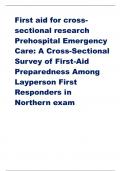First aid for cross-
sectional research
Prehospital Emergency
Care: A Cross-Sectional
Survey of First-Aid
Preparedness Among
Layperson First
Responders in
Northern exam
,Prehospital Emergency Care: A Cross-Sectional Survey of First-Aid Preparedness
Among Layperson First Responders in Northern yet lacks a mature prehospital
emergPrehospital Emergency Care: A Cross-Sectional
Survey of First-Aid Preparedness Among Layperson
First Responders in Northern
Keneth Opiro 1
, Derrick Amone 1
, Margret Sikoti2
, Amos Wokorach1
, Jerom Okot 1
,
Felix Bongomin1
1
Faculty of Medicine, Gulu University, Gulu, Uganda; 2
Department of Nursing, St. Mary’s Hospital Lacor, Gulu, Uganda
Correspondence: Keneth Opiro, Email opiroken@yahoo.co.uk
Background: Uganda has a high incidence of road traffic accidents and high
mortality rates, yet lacks a mature prehospital emergency
care system. Our study addresses this gap by assessing the experiences, training,
and confidence in providing first aid (FA) among
,diverse layperson first responders in Northern Uganda, expanding beyond previous
research, which was limited to Central Uganda and
specific occupational groups.
Methods: We conducted a cross-sectional survey among layperson first responders
of various occupations in Gulu City, Acholi subregion, Uganda. Data on socio-
demographics, training, experiences, knowledge, and confidence in FA were
collected.
Results: We included 396 participants, of whom 81.6% (n=323) were male,
47.0.6% (n=186) were aged 21–30 years, 59.3% (n=235)
had obtained a secondary level of education, 23.7% (n=94) were commercial
motorcyclists, and 45.7% (n=181) had work experience
of >5 years. The majority (85.4%, n=338) had witnessed acute illness/trauma.
Accidents/bleeding were the most commonly witnessed
cases (68.6%, n=232), followed by burn injuries (10.1%, n=34). Most participants
(52.3%, n=207) had attended FA training. Only
20.5% (n=81) had obtained an above-average score (≥70%). The majority (67.9%,
n=269) were confident in providing FA. Lack of
knowledge and skills (61.4%, n=78), fear of taking health risks (18.9%, n=24), and
legal implications (7.1%, n=9) were the major
reasons for not being willing to confidently give FA. Factors associated with
above-average knowledge were tertiary education and
being confident in providing FA, while training in FA and prior experience in
giving FA were associated with confidence in giving FA.
Conclusion: In this study, laypeople in Northern Uganda exhibited a high level of
FA training. However, low confidence in providing
FA is attributed to inadequate knowledge, fear of health risks, and legal concerns.
Therefore, future efforts should focus on assessing
FA practices in diverse regions and promoting formal FA training.
Keywords: first aid, laypeople, prehospital emergency care
Background
, The prognosis of both medical and trauma emergencies can be significantly
improved if proper care is initiated early
enough, which can be on the scene or during transportation to the hospital,1 but
this can be challenging in a setting with
no or minimally developed formal prehospital emergency care systems.2
Prehospital care involves healthcare services
given to patients with emergency conditions before reaching hospital. A survey of
mortality in three different countries
with varying economic levels revealed that the majority of deaths occurred in
prehospital settings, indicating the
importance of first aid (FA) in improving outcomes.3
Trauma accounts for more than 16% of the global burden of disease.4 It is
predicted that by 2030, road traffic
accidents will be the third leading cause of death, well ahead of myocardial
infarction, and, more significantly, one of the
leading causes of disability-adjusted life-years lost globally.5 Over 25% of injury
deaths are from road traffic accidents,
and 90% of mortality from trauma occurs in low- and middle-income countries
with poor prehospital care.6,7
Open Access Emergency Medicine 2024:16 191–202 191
© 2024 Opiro et al. This work is published and licensed by Dove Medical Press
Limited. The full terms of this license are available at
https://www.dovepress.com/terms.
php and incorporate the Creative Commons Attribution – Non Commercial
(unported, v3.0) License (http://creativecommons.org/licenses/by-nc/3.0/). By
accessing the
work you hereby accept the Terms. Non-commercial uses of the work are permitted
without any further permission from Dove Medical Press Limited, provided the
work is properly attributed. For




